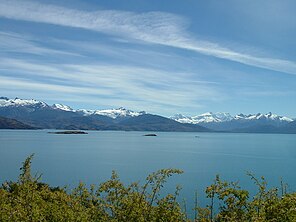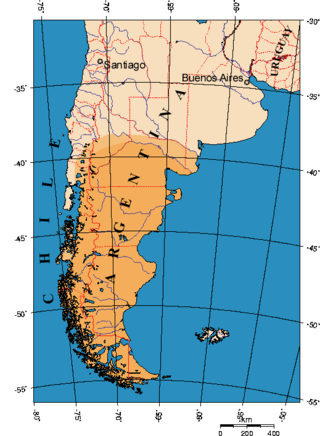
Patagonia is a geographical region that encompasses the southern end of South America, governed by Argentina and Chile. The region comprises the southern section of the Andes Mountains with lakes, fjords, temperate rainforests, and glaciers in the west and deserts, tablelands, and steppes to the east. Patagonia is bounded by the Pacific Ocean on the west, the Atlantic Ocean to the east, and many bodies of water that connect them, such as the Strait of Magellan, the Beagle Channel, and the Drake Passage to the south.
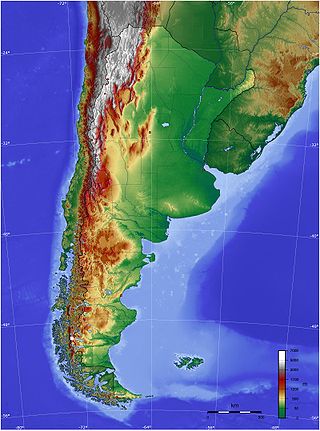
The geography of Argentina is heavily diverse, consisting of the Andes Mountains, pampas, and various rivers and lakes. Bordered by the Andes in the west and the South Atlantic Ocean to the east, its neighbouring countries are Chile to the west, Bolivia and Paraguay to the north, and Brazil and Uruguay to the northeast.

Río Negro is a province of Argentina, located in northern Patagonia. Neighboring provinces are from the south clockwise Chubut, Neuquén, Mendoza, La Pampa and Buenos Aires. To the east lies the Atlantic Ocean.

Santa Cruz Province is a province of Argentina, located in the southern part of the country, in Patagonia. It borders Chubut Province to the north, and Chile to the west and south, with an Atlantic coast on its east. Santa Cruz is the second-largest province of the country, and the least densely populated in mainland Argentina.
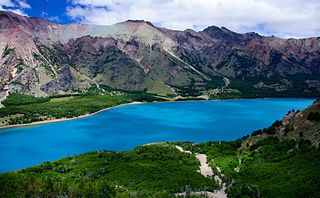
The Aysén del General Carlos Ibáñez del Campo Region, often shortened to Aysén Region or Aisén, is one of Chile's 16 first order administrative divisions. Although the third largest in area, the region is Chile's most sparsely populated region with a population of 102,317 as of 2017. The capital of the region is Coihaique, the region's former namesake. The region's current namesake is the former President of Chile, General Carlos Ibáñez del Campo

Nahuel Huapi Lake is an Andean lake in the lake region of northern Patagonia between the provinces of Río Negro and Neuquén, in Argentina. The lake has a northwest-southeast elongated shape and complex geography with several branches, peninsulas and islands. The city of Bariloche is on the southern shore of the lake and the town of Villa La Angostura lies on its northwestern shores. The lake is wholly inside Nahuel Huapi National Park. It is one of the largest lakes in northern Patagonia. It is drained by Limay River and it is part of the watershed of Negro River which discharges into the South Atlantic.
Chile Chico is a town in General Carrera Province, Aisén Region, Patagonia, Chile. It is located on the south shore of General Carrera Lake. Chile Chico, which has around 3,000 inhabitants, is the eponymous capital of the commune and capital of the General Carrera Province of the Aysén Region.

The lake known as O'Higgins in Chile and San Martín in Argentina is located around coordinates 48°50′S72°36′W in Patagonia, between the Aysén del General Carlos Ibáñez del Campo Region and the Santa Cruz Province.

The Tehuelche people, also called the Aónikenk, are an indigenous people from eastern Patagonia in South America. In the 18th and 19th centuries the Tehuelche were influenced by Mapuche people, and many adopted a horseriding lifestyle. Once a nomadic people, the lands of the Tehuelche were colonized in the 19th century by Argentina and Chile, gradually disrupting their traditional economies. The establishment of large sheep farming estates in Patagonia was particularly detrimental to the Tehuelche. Contact with outsiders also brought in infectious diseases ushering deadly epidemics among Tehuelche tribes. Most existing members of the group currently reside in cities and towns of Argentine Patagonia.
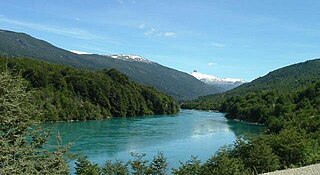
The Baker River is a river located in the Aysén del General Carlos Ibáñez del Campo Region of the Chilean Patagonia. It is Chile's largest river in terms of volume of water. The river flows out of Bertrand Lake, which is fed by General Carrera Lake. It runs along the east side of the Northern Patagonian Ice Field and empties into the Pacific Ocean, near the town of Caleta Tortel. The river forms a delta, dividing into two major arms, of which only the northernmost one is navigable.

The Ibáñez River is a river of Chile located in the Aysén del General Carlos Ibáñez del Campo Region. It has its origin in the skirts of Hudson volcano and flows south-east through the Andes into the General Carrera Lake. The river borders the south side of Cerro Castillo National Reserve, home to Cerro Castillo.

Ferrocarriles Patagónicos was an Argentine State-owned railway company that built and operated several rail lines in Patagonia region. FP were part of the Argentine State Railway created in 1909 during the presidency of José Figueroa Alcorta.

Lake Musters and Lake Colhué Huapí form the terminal stage of the Senguerr River endorheic basin, located in the patagonic central region of Argentina in the south of Chubut province. Closest populated area is Sarmiento, an 8,000 inhabitant former Welsh immigrant colony. The lakes gave their names to the Mustersan and Colhuehuapian South American land mammal ages.
The Magallanes Basin or Austral Basin is a major sedimentary basin in southern Patagonia. The basin covers a surface of about 170,000 to 200,000 square kilometres and has a NNW-SSE oriented shape. The basin is bounded to the west by the Andes mountains and is separated from the Malvinas Basin to the east by the Río Chico-Dungeness High. The basin evolved from being an extensional back-arc basin in the Mesozoic to being a compressional foreland basin in the Cenozoic. Rocks within the basin are Jurassic in age and include the Cerro Toro Formation. Three ages of the SALMA classification are defined in the basin; the Early Miocene Santacrucian from the Santa Cruz Formation and Friasian from the Río Frías Formation and the Pleistocene Ensenadan from the La Ensenada Formation.

Pico Truncado is a town and municipality in Santa Cruz Province in southern Argentina. In 1921, the village's railway station was the site of one of the few open engagements between the Argentine Army and anarchist strikers at the time of the events known as Patagonia rebelde, where the army suffered its only fatality of the campaign.

Patagonia Rebelde was the name given to the uprising and violent suppression of a rural workers' strike in the Argentine province of Santa Cruz in Patagonia between 1920 and 1922. The uprising was put down by Colonel Héctor Benigno Varela's 10th Cavalry Regiment of the Argentine Army under the orders of President Hipólito Yrigoyen. Approximately 300-1,500 rural workers were shot and killed by the 10th Cavalry Regiment in the course of the operations, many of them executed by firing squads after surrendering. Most of the executed were Spanish and Chilean workers who had sought refuge in Argentina's Patagonia after their strike in the city of Puerto Natales in southern Chile in 1919 was crushed by the Chilean authorities, at the cost of four carabiniers killed and the offices of their union were burned by the civilians, policemen and the militaries in Punta Arenas on July 27, 1920. At least two Argentine soldiers, three local policemen and a number of ranch owners and their relatives also died during the strife. According to the versions well publicized by the army and the landowners, several of the captured women were raped in the uprising as the rebel forces fought for control of the territory. These versions have been widely discredited. The most detailed narrative of these events is that by Osvaldo Bayer, summarized in English by Bruce Chatwin in 1976.

Astrapotheriidae is an extinct family of herbivorous South American land mammals that lived from the Late Eocene to the Middle Miocene 37.71 to 15.98 million years ago. The most derived of the astrapotherians, they were also the largest and most specialized mammals in the Tertiary of South America. There are two sister taxa: Eoastrapostylopidae and Trigonostylopidae.

The Golfo San Jorge Basin is a hydrocarbon-rich sedimentary basin located in eastern Patagonia, Argentina. The basin covers the entire San Jorge Gulf and an inland area west of it, having one half located in Santa Cruz Province and the other in Chubut Province. The northern boundary of the basin is the North Patagonian Massif while the Deseado Massif forms the southern boundary of the basin. The basin has largely developed under condition of extensional tectonics, including rifting.
The Lago Colhué Huapí Formation is a Late Cretaceous geologic formation of the Chubut Group in the Golfo San Jorge Basin in Patagonia, Argentina. The formation, named after Lake Colhué Huapí, is overlain by the Salamanca Formation of the Río Chico Group and in some areas by the Laguna Palacios Formation.
Casimiro Biguá was a 19th-century Tehuelche cacique in Patagonia. He opposed the Chilean colonization of the Strait of Magellan and in the 1860s he entered an alliance with Argentine authorities. In a bid to establish Argentine sovereignty over the strait Argentine "ad-hoc agent" Luis Piedra Buena brought Biguá to Buenos Aires where met President Bartolomé Mitre and was declared lieutenant colonel of the Argentine Army and granted a salary accordingly. In 1866 he signed a treaty with Argentine authorities where the Tehuelche were recognized as Argentine citizens and Argentine sovereignty up to the strait of Magellan was declared. The influence of Casimiro Biguá in political affairs declined in the late 1860s.
